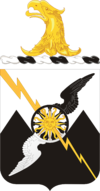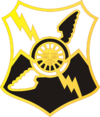|
61st Air Defense Artillery Regiment
The 61st Air Defense Artillery Regiment is an air defense artillery regiment in the United States Army. The lineages of some of the units that initially made up the 61st Artillery (Coast Artillery Corps) (CAC) give the regiment's 1st Battalion campaign credit for the War of 1812. LineageConstituted and activated at Fort Moultrie 9 March 1918 as the 61st Artillery (CAC) from existing Regular and National Guard companies.[1] Demobilized at Camp Upton, New York, 28 February 1919. Reconstituted 1 July 1921 as the 1st Antiaircraft Battalion and organized at Fort Monroe, Virginia. On June 1, 1922, the 61st Artillery Battalion (AA) (CAC) was renamed. Redesignated 61st Coast Artillery (AA) Regiment 30 June 1924 and reorganized as follows-
Reassigned to Fort Sheridan 14 May 1930
18 November 1939 Batteries C and D activated, 28 November 1939 2nd Battalion activated
10 July 1942 two detachments formed as separate Gun Battalions, and later redesignated 494th AAA Gun Battalion, and 495th AAA Gun Battalion.
Regiment deactivated and broken up 14 June 1944 as follows-
28 June 1950 consolidated with elements of the 61st Coast Artillery Regiment which was concurrently reconstituted to form the 61st Antiaircraft Artillery Group with the following composition:
Group Headquarters was established at Camp Stewart, Georgia.
reorganized and redesignated the 61st Artillery Regiment in 1958, and consolidated with the 436th Antiaircraft Artillery Missile Battalion (NIKE), the 548th Antiaircraft Artillery Missile Battalion (NIKE), and the 740th Antiaircraft Artillery Missile Battalion (NIKE) to form the present elements of the regiment. In addition, the 58th Antiaircraft Artillery Battery (EW) at Fort Bliss was reorganized and designated as Battery C (Electronic Warfare), 61st Artillery and assigned to Fourth United States Army. Distinctive unit insigniaDescriptionA Gold color metal and enamel device 7⁄8 inch (2.2 cm) in height overall blazoned as follows: Per fess dancette Argent and Sable, a thunderbolt bendwise Proper penetrating the chariot wheel of Helios winged with two dexter wings inverted forming a saltire with the first charged all counterchanged and upon the wheel the Sun in splendor of the third. SymbolismThe aim and purpose of the unit are told in pictorial form by the story from Greek mythology of the winged chariot of Helios which was brought to Earth by a bolt of lightning thrown by Zeus. A summary of the story is as follows: Helios, the Sun, drove across the heavens from east to west daily, in a winged chariot drawn by the celestial horses. His son, Phaeton, in order to please his mother, and to satisfy those who doubted that he was really a son of Helios, obtained permission from his father to take his place in the chariot for one day. Phaeton had scarcely taken the reins when the celestial horses, despising their weak driver, turned out of their patch and set everything on fire. When the chariot came so near the Earth that the Ethiopians were blackened by the near approach of the Sun, Zeus, with a well-aimed bolt of lightning, wrecked the chariot and sent it plunging into the river Po. This is the first historical record of a hit being scored against an aerial target. The shield is divided by the saw tooth line taken from Lord Delaware's arms which were the basis of the coat of arms for the Coast-Defense of the Chesapeake. The upper part of the shield is white, the lower half black, for day and knight. BackgroundThe distinctive unit insignia was originally approved for the 61st Artillery Battalion on 16 November 1923. It was redesignated for the 61st Coast Artillery Regiment on 12 December 1939. The insignia was redesignated for the 61st Antiaircraft Artillery Automatic Weapons Battalion on 10 August 1955. It was redesignated for the 61st Artillery Regiment on 19 December 1958. It was redesignated for the 61st Air Defense Artillery Regiment effective 1 September 1971. Coat of armsBlazon
Per fess dancette Argent and Sable, a thunderbolt bendwise Proper penetrating the chariot wheel of Helios winged with two dexter wings inverted forming a saltire with the first charged all counterchanged and upon the wheel the sun in splendor of the third.
On a wreath of the colors Argent and Sable, an eagle's head erased Or. Motto NON EST AD ASTRA MOLLIS E TERRIS VIA (The Way To the Stars Is Not Easy). Symbolism
The aim and purpose of the unit are told in pictorial form by the story from Greek mythology of the winged chariot of Helios which was brought to earth by a bolt of lightning thrown by Zeus. A summary of the story is as follows: Helios, the sun, drove across the heavens from east to west daily, in a winged chariot drawn by the celestial horses. His son, Phaeton, in order to please his mother, and to satisfy those who doubted that he was really a son of Helios, obtained permission from his father to take his place in the chariot for one day. Phaeton had scarcely taken the reins when the celestial horses, despising their weak driver, turned out of their patch and set everything on fire. When the chariot came so near the earth that the Ethiopians were blackened by the near approach of the sun, Zeus, with a well aimed bolt of lightning, wrecked the chariot and sent it plunging into the river Po. This is the first historical record of a hit being scored against an aerial target. The shield is divided by the saw tooth line taken from Lord Delaware's arms which were the basis of the coat of arms for the Coast-Defense of the Chesapeake. The upper part of the shield is white, the lower half black, for day and knight.
The crest is from the arms of James Monroe with the colors reversed, a red eagle's head on a gold shield. BackgroundThe coat of arms was originally approved for the 1st Antiaircraft Battalion on 25 October 1921. It was redesignated for the 61st Battalion (Antiaircraft) on 10 June 1922. It was redesignated for the 61st Coast Artillery Regiment on 15 December 1939. The insignia was redesignated for the 61st Antiaircraft Artillery Automatic Weapons Battalion on 10 August 1955. It was redesignated for the 61st Artillery Regiment on 19 December 1958. It was redesignated for the 61st Air Defense Artillery Regiment effective 1 September 1971. Campaign streamersWorld War I
World War II • Iceland, 1942 & 1943 • England, 1943 & 1944 • Normandy, 1944 • Northern France, 1944 • Ardennes-Alsace, 1944 • Rhineland, 1944 & 1945 • Central Europe, 1945 Korea
Decorations
References
External links
|
||||||||||||||||||||||||

